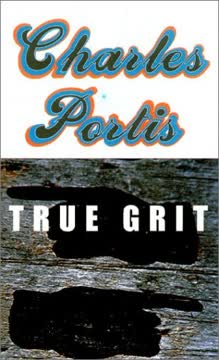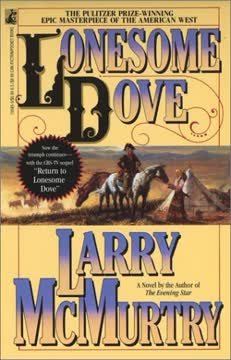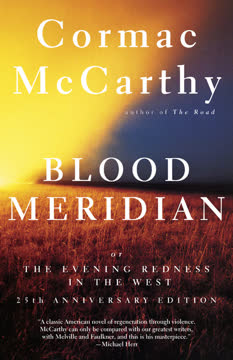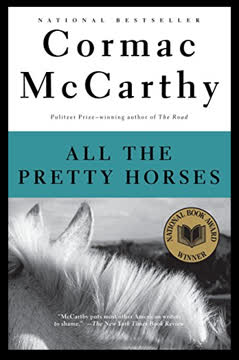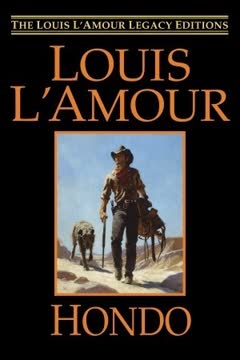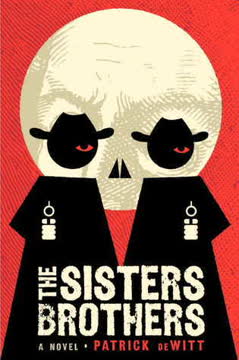Plot Summary
A Father's Tragic End
Fourteen-year-old Mattie Ross is determined to avenge her father's murder. Her father, Frank Ross, was killed by a man named Tom Chaney in Fort Smith, Arkansas. Chaney, a tenant on the Ross family farm, shot Frank over a card game dispute and fled with his money and horse. Mattie, driven by a sense of justice and duty, sets out to bring Chaney to justice, despite her youth and the skepticism of those around her.
The Quest for Justice
Mattie travels to Fort Smith to retrieve her father's body and settle his affairs. She is undeterred by the challenges she faces, including the indifference of local law enforcement. She learns that Chaney has joined a gang led by the notorious outlaw Lucky Ned Pepper. Mattie decides to hire a U.S. Marshal to track down Chaney, seeking someone with "true grit" to help her in her quest.
Meeting Rooster Cogburn
Mattie chooses Rooster Cogburn, a one-eyed, hard-drinking U.S. Marshal known for his toughness. Despite his rough exterior and questionable methods, Mattie believes Rooster is the man for the job. She offers him a reward to capture Chaney, and after some negotiation, Rooster agrees to take on the task. Mattie's determination impresses Rooster, and they set out together, forming an unlikely partnership.
A Texan Joins the Hunt
As Mattie and Rooster prepare to leave, they encounter LaBoeuf, a Texas Ranger also on Chaney's trail for killing a senator. LaBoeuf proposes joining forces, but Mattie is wary of his intentions, fearing he will take Chaney back to Texas for his own reward. Despite her reservations, Rooster agrees to the partnership, seeing the advantage of having another skilled gunman on their side.
Into the Indian Territory
The trio sets off into the Indian Territory, facing harsh weather and rough terrain. Mattie proves her resilience, keeping pace with the seasoned lawmen. Along the way, they gather information about Lucky Ned Pepper's gang and their whereabouts. The journey tests their endurance and trust in one another, as they navigate the dangers of the outlaw-infested territory.
The Bandits' Lair
The group tracks the gang to their hideout in the Winding Stair Mountains. A tense standoff ensues, with Rooster and LaBoeuf planning an ambush. However, the plan goes awry, leading to a chaotic gunfight. Mattie finds herself face-to-face with Chaney, and in a moment of courage, she shoots him, though not fatally. The situation escalates, and Mattie is captured by the gang.
A Final Reckoning
In a dramatic showdown, Rooster charges the gang, displaying the true grit Mattie sought. LaBoeuf's sharpshooting skills prove crucial, as he takes down Lucky Ned Pepper. Mattie, trapped in a pit with rattlesnakes, is rescued by Rooster, but not before suffering a snakebite and a broken arm. The ordeal leaves her physically scarred but victorious in her quest for justice. Rooster's heroics and LaBoeuf's assistance ensure Chaney's capture, bringing closure to Mattie's mission.
Characters
Mattie Ross
Mattie is a headstrong and resourceful fourteen-year-old girl driven by a strong sense of justice. Her father's murder propels her into a world of danger and adventure. Despite her youth, she displays remarkable courage and tenacity, refusing to be underestimated by the adults around her. Her journey is one of growth and resilience, as she learns the harsh realities of the world while staying true to her mission.
Rooster Cogburn
Rooster is a one-eyed U.S. Marshal with a reputation for toughness and a fondness for whiskey. Beneath his rough exterior lies a man of principle, willing to take on dangerous tasks for the right reasons. His relationship with Mattie evolves from skepticism to respect, as he recognizes her determination and shares in her quest for justice. Rooster's actions in the final showdown reveal his true character and bravery.
LaBoeuf
LaBoeuf is a Texas Ranger with his own reasons for pursuing Tom Chaney. Initially at odds with Mattie, he eventually becomes a valuable ally in the hunt. His sharpshooting skills and knowledge of the territory prove crucial in the final confrontation. LaBoeuf's motivations are complex, balancing personal gain with a sense of duty, and his presence adds depth to the dynamic between the main characters.
Tom Chaney
Chaney is the man responsible for Frank Ross's murder, setting the story in motion. He is portrayed as a cowardly and opportunistic criminal, lacking the moral compass that drives Mattie. His actions are motivated by self-preservation and greed, leading him to align with outlaws like Lucky Ned Pepper. Chaney's encounter with Mattie highlights his weakness and ultimately leads to his downfall.
Lucky Ned Pepper
Lucky Ned is the leader of the gang Chaney joins. He is a seasoned criminal with a reputation for cunning and brutality. Despite his criminal ways, he exhibits a code of conduct among his men, which contrasts with Chaney's treachery. Lucky Ned's interactions with Rooster and Mattie reveal a complex character who commands respect and fear in equal measure.
Plot Devices
True Grit
The concept of "true grit" is central to the narrative, representing the courage and determination required to pursue justice against all odds. Mattie's unwavering resolve and Rooster's fearless approach to law enforcement embody this theme. The story explores the moral complexities of justice and the personal sacrifices made in its pursuit, highlighting the grit needed to confront evil.
The Journey
The physical journey into the Indian Territory serves as a metaphor for Mattie's personal growth and the challenges she faces. The harsh landscape and encounters with danger test her limits and force her to confront her fears. The journey is a rite of passage, marking her transition from innocence to experience, and ultimately shaping her understanding of justice and morality.
The Ambush
The ambush at the bandits' hideout is a key plot device that heightens tension and propels the story toward its climax. The failed plan and ensuing chaos reveal the characters' true natures and test their loyalty to one another. The ambush serves as a turning point, leading to the final confrontation and resolution of Mattie's quest for vengeance.
Analysis
"True Grit" is a story that explores themes of justice, courage, and the complexities of human nature. Through Mattie's journey, the narrative examines the moral ambiguities of revenge and the personal cost of pursuing justice. The characters' interactions reveal the nuances of loyalty, trust, and the impact of past experiences on present actions. The novel's portrayal of the American frontier highlights the harsh realities of life in a lawless land, where individuals must rely on their inner strength and grit to navigate a world fraught with danger and uncertainty. Ultimately, "True Grit" is a testament to the enduring human spirit and the relentless pursuit of what is right, even in the face of overwhelming odds.
Last updated:
FAQ
Synopsis & Basic Details
What is True Grit about?
- A Young Girl's Vengeance: Fourteen-year-old Mattie Ross embarks on a relentless quest to avenge her father, Frank Ross, who was murdered by their tenant Tom Chaney in Fort Smith, Arkansas.
- Hiring a Tough Marshal: Undeterred by her youth and the dangers of the Indian Territory, Mattie hires Reuben "Rooster" Cogburn, a one-eyed, hard-drinking U.S. Marshal known for his "true grit," to track down Chaney.
- An Unlikely Trio's Hunt: Their journey is complicated by the arrival of LaBoeuf, a Texas Ranger also pursuing Chaney for a separate murder, forcing the three into an uneasy alliance against the backdrop of a lawless frontier.
Why should I read True Grit?
- Unforgettable Narrative Voice: Charles Portis crafts a unique, formal, and often humorous first-person narration through the adult Mattie Ross, offering a distinctive perspective on a classic Western tale. Her precise, almost legalistic language contrasts sharply with the brutal events she recounts.
- Complex Character Studies: The novel delves deep into the motivations and moral ambiguities of its characters, particularly Mattie's unwavering resolve, Rooster's flawed heroism, and LaBoeuf's evolving sense of duty, making them far more than simple archetypes.
- Authentic Frontier Realism: Beyond the adventure, the book provides a gritty, unsentimental portrayal of the post-Civil War American West, exploring themes of justice, revenge, and survival with historical detail and a keen eye for the harsh realities of the time.
What is the background of True Grit?
- Post-Civil War Frontier: The story is set in the late 19th century, primarily in Fort Smith, Arkansas, and the Indian Territory (present-day Oklahoma), a region known for its lawlessness and as a refuge for outlaws. This historical context of a still-untamed West, where federal law often struggled to assert authority, is crucial to the plot.
- Judge Isaac Parker's Court: The narrative frequently references Judge Isaac Parker, the "Hanging Judge" of Fort Smith, whose court had jurisdiction over the Indian Territory. His strict, often brutal, application of the law and the high number of executions under his tenure underscore the harsh justice system of the era, as Mattie notes, "I know sixty-five of his marshals got killed."
- Cultural and Social Dynamics: The book subtly explores the cultural landscape, including interactions between white settlers, various Native American tribes (Cherokee, Choctaw, Creek), and the lingering divisions from the Civil War, as seen in Rooster's past as a Confederate bushwhacker and his later service as a U.S. Marshal.
What are the most memorable quotes in True Grit?
- "People do not give it credence that a fourteen-year-old girl could leave home and go off in the wintertime to avenge her father's blood but it did not seem so strange then...": This opening line immediately establishes Mattie's extraordinary character and the novel's unique perspective, setting the tone for her improbable quest.
- "I was just fourteen years of age when a coward going by the name of Tom Chaney shot my father down in Fort Smith, Arkansas, and robbed him of his life and his horse and $150 in cash money plus two California gold pieces that he carried in his trouser band.": This direct and factual statement encapsulates Mattie's motivation and the precise, almost legalistic nature of her grievance, highlighting her focus on tangible losses beyond just her father's life.
- "Fill your hand, you son of a bitch!": Uttered by Rooster Cogburn as he charges four bandits alone, this iconic line epitomizes his reckless courage and the raw, unrefined "true grit" that Mattie sought, showcasing his willingness to face overwhelming odds head-on.
What writing style, narrative choices, and literary techniques does Charles Portis use?
- First-Person Retrospective Narration: The story is told by an adult Mattie Ross looking back on her youth, lending a formal, precise, and often wryly humorous tone to the brutal events. This narrative distance allows for both objective recounting and subtle emotional undertones, as she reflects on her past self.
- Dry Wit and Understated Humor: Portis employs a distinctive dry wit, often through Mattie's matter-of-fact observations and her interactions with the rougher characters. Her precise language and moral judgments, even in the face of absurdity or violence, create a unique comedic effect, such as her assessment of Mrs. Floyd's biscuits or her legalistic haggling with Stonehill.
- Detailed Realism and Dialogue: The novel is rich in authentic period details, from descriptions of frontier life to the specific weaponry and legal procedures of the time. The dialogue is sharp, regional, and character-defining, revealing personalities and power dynamics through their distinct speech patterns, like Rooster's folksy pronouncements and Mattie's formal challenges.
Hidden Details & Subtle Connections
What are some minor details that add significant meaning?
- The California Gold Pieces: Frank Ross's two California gold pieces, a marriage gift from Mattie's grandfather, are not just stolen money but a symbolic link to family and a tangible representation of Chaney's complete violation. Mattie's recovery of one piece from Quincy's pocket in Chapter 6 is a small but significant victory, confirming Chaney's association with the gang and fueling her resolve.
- Mattie's Accounting Skills: From the outset, Mattie's meticulous record-keeping for her father ("I kept his books for him") and her sharp financial acumen (negotiating with Stonehill, correcting Rooster's fee sheets) highlight her precocious intelligence and practical nature. This detail underscores her capability to navigate a man's world and her methodical approach to justice, treating it almost as a business transaction.
- Rooster's Cat, General Sterling Price: The presence of Rooster's fat brindle cat, named after a Confederate general, offers a subtle glimpse into Rooster's domestic life and his lingering ties to his past. The cat's name is a nod to Rooster's Confederate service, and his affection for the animal contrasts with his rough exterior, hinting at a softer, more complex inner world.
What are some subtle foreshadowing and callbacks?
- The Pit of Snakes: Chaney's threat to throw Mattie into a pit of rattlesnakes in Chapter 7 is a direct and chilling callback to his earlier, seemingly casual mention of a "ball of rattlesnakes" in the same pit. This foreshadows Mattie's eventual fall into the pit, intensifying the horror of her snakebite and near-death experience.
- Mattie's Arm Injury: Early in the book, Mattie mentions her "strong right arm" in a letter from Lawyer Daggett, who calls her "her strong right arm now, Mattie." This seemingly innocuous detail foreshadows the tragic loss of her arm at the end of the story, making the physical cost of her quest even more poignant and ironic.
- Rooster's Past as a Bushwhacker: Rooster's casual recounting of his violent past, including riding with Quantrill and robbing a Federal paymaster, subtly foreshadows his morally ambiguous methods and his willingness to bend or break the law in pursuit of his own brand of justice. It explains his "true grit" but also his questionable ethics, which Mattie later confronts.
What are some unexpected character connections?
- Rooster and Columbus Potter: Rooster's deep bond with his former marshal partner, Columbus Potter, is revealed through his emotional testimony at the Wharton trial and his later lament about Potter's absence when doing paperwork. This connection highlights Rooster's capacity for loyalty and grief, contrasting with his gruff demeanor, and shows the profound impact of his past relationships on his present self.
- LaBoeuf's War Service: LaBoeuf's pride in his Confederate service, despite being a young recruit who "counted beeves and sacked oats," creates an unexpected parallel with Rooster's own Confederate past. Their shared history, though experienced differently, forms a subtle bond that transcends their initial animosity and contributes to their eventual, albeit uneasy, alliance.
- The Permalee Family's Criminality: The detailed description of the Permalee family's long history of crime, from Henry Joe's train wrecking to Carroll's execution and Darryl's death, reveals a generational pattern of lawlessness. This background provides a stark contrast to Mattie's family values and underscores the pervasive nature of crime in the Indian Territory, showing the deep roots of the world she has entered.
Who are the most significant supporting characters?
- Colonel Stonehill: The stock trader in Fort Smith, Stonehill, serves as Mattie's first significant adult adversary and a test of her business acumen. His initial dismissal of her ("I do not like to deal with children") and subsequent capitulation to her demands ("You are an unnatural child") establish Mattie's formidable will and foreshadow her ability to manipulate and outmaneuver powerful men.
- Yarnell Poindexter: The "colored man" who works for the Ross family, Yarnell, represents a steadfast and loyal figure in Mattie's life, accompanying her to Fort Smith and offering practical advice. His journey from being kidnapped into slavery to becoming a prosperous house painter in Memphis highlights themes of resilience and social mobility in the post-Civil War South, providing a quiet counterpoint to the violence of the frontier.
- Mrs. Floyd, the Boardinghouse Keeper: Mrs. Floyd, with her gossipy nature and intrusive questions, provides a glimpse into the social fabric of Fort Smith and the public's fascination with sensational events like hangings and murders. Her character serves as a foil to Mattie's reserved and private nature, emphasizing Mattie's discomfort with idle curiosity and her focus on her mission.
Psychological, Emotional, & Relational Analysis
What are some unspoken motivations of the characters?
- Mattie's Need for Control: Beyond simple revenge, Mattie's relentless pursuit of Chaney is driven by a deep-seated need to restore order and control to her life after her father's sudden, senseless death. Her meticulous planning and insistence on her terms ("I will have my way") reflect a psychological effort to regain agency in a world that has violently disrupted her sense of security.
- Rooster's Search for Redemption/Purpose: Rooster's willingness to take on dangerous jobs, despite his cynicism and drinking, suggests an underlying need for purpose or a form of redemption. His past as a bushwhacker and his failed personal life (divorced wife, estranged son) imply a man seeking to prove his worth, perhaps to himself, through his "dangerous work" as a marshal, as explored in "Rooster Cogburn character analysis."
- LaBoeuf's Desire for Recognition: LaBoeuf, the Texas Ranger, is motivated not just by the reward money but also by a strong desire for professional recognition and validation. His constant references to Ranger policy and his initial attempts to assert authority over Mattie and Rooster reveal a man eager to prove his competence and earn respect in a challenging environment, a key aspect of "LaBoeuf character analysis."
What psychological complexities do the characters exhibit?
- Mattie's Precocity and Trauma: Mattie exhibits a remarkable blend of childlike innocence and adult pragmatism, a psychological complexity born from her traumatic experience. Her ability to negotiate with hardened men and witness gruesome events without flinching ("I have never been one to flinch or crawfish") masks a deep emotional cost, which only surfaces in moments of extreme stress or in her later, reflective narration.
- Rooster's Moral Ambiguity: Rooster embodies a complex moral code, operating outside conventional legal and ethical boundaries while still serving a form of justice. His past as a "road agent" and his brutal methods ("I never shot nobody I didn't have to") reveal a man shaped by a violent world, yet his loyalty to Mattie and his ultimate self-sacrifice demonstrate a hidden integrity, making his "Rooster Cogburn character" deeply nuanced.
- LaBoeuf's Pride and Vulnerability: LaBoeuf's initial arrogance and "stuck-up" manner hide a surprising vulnerability, particularly after his injury and his near-whipping of Mattie. His pride is easily wounded, but his eventual acceptance of Mattie's presence and his crucial role in saving Rooster's life show a capacity for growth and genuine heroism, adding layers to "LaBoeuf character analysis."
What are the major emotional turning points?
- The Triple Hanging: Witnessing the public execution in Fort Smith, particularly the Indian's prolonged strangulation and the yellow-haired man's tearful last words, is a profound emotional turning point for Mattie. It exposes her to the brutal reality of frontier justice and the finality of death, hardening her resolve while also stirring her empathy, a key moment in "Mattie Ross motivations."
- Rooster's Defense of Mattie: When LaBoeuf attempts to whip Mattie, Rooster intervenes, drawing his pistol and threatening the Texan. This act marks a significant shift in their relationship, as Rooster moves from reluctant guardian to protector, demonstrating his growing respect and affection for Mattie, and solidifying their unlikely bond.
- Mattie's Fall into the Snake Pit: Mattie's fall into the pit of rattlesnakes after shooting Chaney is the climax of her emotional and physical ordeal. This terrifying experience, culminating in her snakebite and broken arm, represents the ultimate cost of her quest for vengeance, forcing her to confront her own mortality and the harsh consequences of her "true grit."
How do relationship dynamics evolve?
- Mattie and Rooster: From Employer to Paternal Figure: Their relationship begins as a strictly transactional one, with Mattie hiring Rooster. Over the journey, Mattie's unwavering determination earns Rooster's respect, and he gradually assumes a paternal, protective role, culminating in his desperate efforts to save her life. This evolution is central to "themes in True Grit," highlighting unexpected bonds.
- Mattie and LaBoeuf: From Antagonism to Mutual Respect: Initially, Mattie and LaBoeuf are at odds, clashing over Chaney's fate and LaBoeuf's attempts to assert authority. Their shared dangers and LaBoeuf's eventual sacrifice for Mattie and Rooster forge a grudging respect, transforming their dynamic from rivalry to a functional, if still prickly, alliance.
- Rooster and LaBoeuf: Professional Rivalry to Comradeship: Their relationship is marked by professional jealousy and cultural clashes (Texas Ranger vs. Federal Marshal). Despite their constant bickering and Rooster's contempt for LaBoeuf's "Texas waddie" ways, they ultimately prove to be effective partners in combat, relying on each other's skills in the final showdown, showcasing a complex "Rooster Cogburn character" interaction.
Interpretation & Debate
Which parts of the story remain ambiguous or open-ended?
- Rooster Cogburn's True Past: While Rooster recounts parts of his past, particularly his time with Quantrill and his "road agent" activities, the full extent of his moral compromises remains ambiguous. Mattie herself questions his "stretching the blanket," leaving readers to debate the veracity of his claims and the true nature of his "true grit" – was he a lawman who sometimes broke the law, or a criminal who found a legal outlet for his violence?
- The Nature of "True Grit": The novel constantly explores what "true grit" actually means. Is it Mattie's unwavering resolve, Rooster's reckless courage, or LaBoeuf's quiet endurance? The story doesn't offer a single definition, leaving it open to interpretation whether grit is an admirable quality, a stubborn flaw, or a necessary but costly trait for survival in a brutal world.
- The Long-Term Impact on Mattie's Soul: While Mattie achieves her vengeance, the narrative leaves open the question of the psychological cost. Her adult narration is detached and factual, but the loss of her arm and her lifelong unmarried status suggest a profound, perhaps isolating, impact from her youthful quest. The story doesn't explicitly state if her "true grit" brought her lasting peace or merely a different kind of burden.
What are some debatable, controversial scenes or moments in True Grit?
- LaBoeuf's Attempted Whipping of Mattie: The scene where LaBoeuf attempts to whip Mattie for her stubbornness is highly controversial, highlighting the brutal realities of the era and the gender dynamics at play. While Rooster intervenes, the moment forces readers to confront the vulnerability of a young girl in a man's world and the harsh disciplinary methods considered acceptable at the time, sparking debate about the characters' morality.
- Rooster's "Justice" vs. Legal Due Process: Rooster's methods, such as his high body count ("Around twelve or fifteen... I believe them two Whartons made twenty-three") and his willingness to kill rather than capture, are constantly debated within the story and by readers. His actions raise questions about whether his "justice" is truly just, or merely a violent expediency, especially in the context of Judge Parker's "slaughterhouse" court.
- The Treatment of Native American Characters: The portrayal of Native American characters, from the "civilized Creeks and Cherokees" to the "heathen" Indian at the hanging, can be seen as controversial. While Mattie's narration reflects the attitudes of her time, the novel's depiction of their roles and the casual racism ("darkies," "nigger") present in dialogue invites discussion on historical accuracy versus modern sensibilities.
True Grit Ending Explained: How It Ends & What It Means
- Chaney's Demise and Mattie's Sacrifice: The "True Grit ending explained" reveals Mattie finally kills Tom Chaney, but not before he injures LaBoeuf and causes her to fall into a snake pit, where she is bitten and breaks her arm. Rooster's heroic rescue, involving a desperate ride to save her from the snake venom, ultimately leads to the amputation of her arm, a permanent physical cost for her vengeance.
- The Cost of Vengeance and Grit: Mattie's lost arm symbolizes the profound personal sacrifice and the high price of her quest for justice. While she achieves her goal, the ending suggests that "true grit" is not without its severe consequences, leaving her physically scarred and, as an adult, seemingly emotionally detached, highlighting the "themes in True Grit" about the burden of revenge.
- Rooster's Fading Glory and LaBoeuf's Disappearance: Rooster, after saving Mattie, loses his badge due to another controversial shooting and ends up in a Wild West show, a shadow of his former self, eventually dying alone. LaBoeuf, after recovering Chaney's body, disappears from Mattie's life. This bittersweet conclusion emphasizes the transient nature of frontier heroism and the ultimate solitude of those who live by "true grit," leaving Mattie as the sole, enduring witness to their shared, brutal history.
Review Summary
True Grit is widely praised as a classic Western novel with memorable characters, especially the determined 14-year-old Mattie Ross. Readers appreciate Portis's authentic dialogue, deadpan humor, and vivid portrayal of the Old West. The story of Mattie seeking revenge for her father's murder, aided by one-eyed Marshal Rooster Cogburn, captivates audiences across generations. Many reviewers note the book's superior quality compared to its film adaptations and highlight Mattie's unique voice as a narrator. The novel's blend of adventure, comedy, and poignant moments earns it consistent five-star ratings.
Similar Books
Download PDF
Download EPUB
.epub digital book format is ideal for reading ebooks on phones, tablets, and e-readers.
